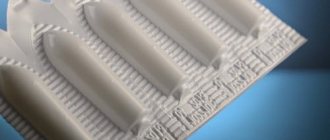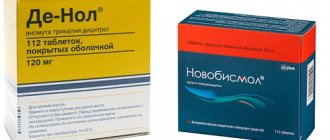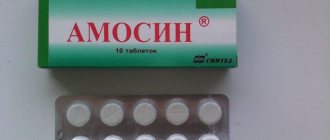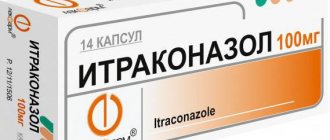Anti-diarrhea tablets brief overview
Drugs to restore the body’s water balance are where treatment should begin.
Regudron and Citrogluxolan are salts that are washed out of the body during abdominal diarrhea and restore water balance in the body. Regudron is sold in every pharmacy; Citrogyxolan is very rare. The price is on average 30 rubles per bag.
Adsorbents
These drugs simply need to be in your home medicine cabinet. Absorbents collect all negative toxins and poisons. The first thing you need to drink when starting treatment for diarrhea is absorbents. These include:
Activated carbon (Carbo activatus)
The tablets are black, odorless, colorless and tasteless.
- Pharmacological action: Adsorbent that is capable of absorbing alkaloids, glycosides, and toxins. It has great activity even in the presence of heavy metals in the stomach.
- Indications for use: Poisoning, intoxication, diarrhea, alcohol poisoning.
- Directions for use and doses: Doses for children from seven years of age and adults, one tablet three times a day between meals. For children under seven years old - half a tablet three times a day. The course of treatment is about a week. It all depends on the state of the body, what form of intensification. It has a fairly low price and is very popular.
Smecta or Diosmectin (Diosmectite)
- Pharmacological action: Pharmacological agent of natural origin. It has good protective properties against mucous membranes and has an absorbent effect. Smecta creates a barrier between the mucous membrane and the contents of the stomach, thereby having a positive effect on diarrhea. Smecta also has an enveloping function.
- Indications for use: Relieves the condition during poisoning and diseases of the esophagus, stomach, duodenum. chronic diarrhea (diarrhea), especially in children.
- Directions for use and dosage: Adults 3 sachets per day, children under 1 year of age 1 sachet per day, from 1-2 years old two sachets per day, over 2 years old – 2-3 sachets per day. Can be mixed with any semi-liquid product, such as jelly or baby food. Costs on average about 200 rubles for 10 bags.
Neontestapon, Kaopectat, Capet, Reaban, Attapulgite
- Pharmacological action: Anti-diarrhea drug. Natural aluminum magnesium is active when heated and has a strong adsorption function. In the gastrointestinal tract, it adsorbs pathogenic substances and toxins, reduces inflammation of the mucous membrane. Relieves spasms, helps normalize stomach flora. Has an astringent effect. Thickens the stool.
- Indications for use: Acute diarrhea, disturbance of intestinal microflora, inflammation of the mucous membrane.
- Directions for use and dosage: Adults and children over 12 years of age, 150 mg, repeat after each stool. Children from 6 years to 12 years: 0.75 mg, repeat after the next bowel movement. Take the first dose after the first signs of diarrhea. The duration of the course is no more than 2 days. The tablets are taken without chewing with water. For young children, a suspension is prescribed.
Medicines that can stop diarrhea
Imodium is highly advertised today. Let's figure out what this “miracle drug” is.
Imodium consists of Loperemide. So, by and large, this is one drug from different manufacturers. It is believed that Imodium is of higher quality and purified. Both Imodium and Loperamide have similar indications and dosages:
Imodium
- Pharmacological action: Antidiarrheal drug. Interacts with receptors on the walls of the stomach and slows down peristasis. This increases the time it takes to digest food. Able to increase the tone of the anus, significantly reduces the urge to dysfunction.
- Indications: acute diarrhea, stool regulation.
- Dosage: Adults: 4 mg, and subsequently 2 mg after each stool. This increases the frequency of stools to 2 times a day. The maximum dose per day is 16 mg, for children it is calculated at 0.3 g per kilogram of weight. No more than twice a day.
You can buy Imodium in two forms - packs of 6 and 12 pieces. The average price for 6 pieces is from 155-180 rubles, for 12 pieces - 200 rubles.
Loperamide
- Pharmacological action: Antidiarrheal drug. Reduces gastrointestinal motility. Increases the tone of the anal area.
- Indications: acute diarrhea, stool regulation.
- Dosage: For adults and children over 12 years of age, 4 mg, then 2 mg after each stool. No more than 16 mg per day. For children under 12 years of age, the first dose of Loperamide is 2 mg, then 1 mg, taken twice a day. Maximum 6 mg per day.
Loperamide costs from 25-100 rubles, depending on the manufacturer.
Thus, Loperamide has its advantages in terms of price, Imodium in quality and manufacturer. It is up to the buyer to decide whether it is better to choose Imodium or Loperamide.
Antibiotics and antimicrobials
In particularly difficult cases, diarrhea is accompanied by an inflammatory process. In these cases, antimicrobial drugs or antibiotics are prescribed. Today they are presented in a huge assortment, but the most popular are Furazolidone and Levomycetin. These tablets have been prescribed for more than one generation and have proven themselves quite well in the market for these products. Furazolidone and Levomycetin are fairly inexpensive drugs. They cost around 50 rubles and are available to all segments of the population.
Composition and pharmacological action
Despite the general indication for use (diarrhea), the drugs have quite a lot of differences.
The main difference is the composition. Nifuroxazide in Enterofuril is an antimicrobial agent that inhibits the activity of pathogenic bacteria . The activity of the active substance is manifested against the most common pathogens of intestinal infections. The advantage of Enterofuril is the absence of a negative effect on the normal intestinal microflora. This property further increases the effectiveness of the product, since competitive antagonism of beneficial microflora is added to the strength of the active component.
The active substance enterofuril is ineffective against viral intestinal infections, but is sometimes prescribed for such diagnoses to prevent bacterial complications. Only a doctor can determine the etiology of diarrhea. The drug is available without a prescription and has a high safety profile, but should not be used as first aid for every bowel disorder, since it is prescribed specifically for infectious diarrhea.
Loperamide contains the active ingredient of the same name. Unlike nifuroxazide, it belongs to the group of antidiarrheal and not antimicrobial agents. The pharmacological effect is based on interaction with receptors of the intestinal wall. After oral administration, Loperamide helps slow down the peristalsis of the organ and increase the tone of the anal sphincter. This helps reduce the number of trips to the toilet and prevent significant fluid loss.
However, this mechanism of action is considered more of a symptomatic treatment that is used to stop diarrhea, but not to combat its cause. The positive effect of Loperamide is the prevention of loss of fluid and electrolytes due to retention of contents in the intestinal lumen, as well as increased absorption of salts and water into the systemic bloodstream. This makes it possible to improve the patient’s condition and wait until etiotropic therapy begins to act. The pharmacological effect after taking tablets and capsules develops quickly and lasts for several hours.
The simultaneous use of both drugs is possible, but to prescribe Enterofuril you need to be sure that the problem is caused by pathogenic bacteria. For other etiologies of diarrhea, the drug will be useless. In this case, the effect of Loperamide will manifest itself regardless of the causes of diarrhea. In complex therapy, Loperamide is first taken to retain the contents in the intestines, and then Enterofuril, which can fully exert its effect. If the pathogen is Salmonella or Shigella, Loperamide is contraindicated.
Designed by jcomp / Freepik
Conclusion
Treatment of diarrhea is not only necessary, but also must be done as soon as possible. Your home medicine cabinet should always contain medicines for diarrhea and poisoning. Remember, you are not a doctor, which means that if you have any signs of diarrhea, it is best to consult a specialist.
Especially if you are going to take the antibiotic Levomycetin or Furazolidone. At the hospital you will receive professional help. There you will also be prescribed the pills that you need to take specifically in your case. When purchasing any medicines, look at the production date. If you have little material wealth, you should ask your doctor to prescribe you a cheaper alternative to expensive drugs. It’s up to you to decide which tablets to buy, expensive or cheap. Before taking the pills, read the instructions carefully and be sure to pay attention to the contraindications.
The site provides reference information for informational purposes only. Diagnosis and treatment of diseases must be carried out under the supervision of a specialist. All drugs have contraindications. Consultation with a specialist is required!
Loperamide
is a medicine intended to treat diarrhea.
The drug reduces the motor activity of the gastrointestinal tract and inhibits the movement of intestinal contents. Today, the drug Loperamide is produced by various pharmaceutical concerns, which give their own sonorous names to this drug. Thus, on the Russian market there are drugs with the following names: 1.
Loperamide is produced by WARSAW PHARMACEUTICAL WORK POLFA.
2.
Loperamide Acri is produced by the AKRIKHIN Chemical and Pharmaceutical Plant.
3.
Loperamide STADA is produced by Nizhpharm LLC.
4.
Loperamide hydrochloride is produced by Kimica Synthetica S.A.
in Spain, and the Borisov Pharmaceutical Plant in the Republic of Belarus. 5.
Vero-Loperamide is produced by Vero-Pharm OJSC.
All this is, in fact, the same drug, which has different names given to it by the manufacturer. All medications contain the active substance loperamide hydrochloride
, at a dosage of 2 mg per capsule.
Smecta or neosmectin: which is better and what is the difference (differences in composition, reviews from doctors)
Smecta and Neosmectin are enterosorbents that help fight gastrointestinal disorders. The first medicine is produced in France, and the second in Russia. They have almost the same effect, but there is a difference between them.
Smecta and Neosmectin are enterosorbents that help fight gastrointestinal disorders.
Characteristics of Neosmectin
This is an adsorbent drug. Its main component is dioctahedral smectite. The medicine is produced in the form of a powder that has different flavors, from which a suspension is prepared. Its main purpose is the treatment of diarrhea of various origins.
Neosmectin is an adsorbent drug.
The drug increases the amount of mucus and normalizes the mucous barrier in the gastrointestinal tract. Thanks to the active component, a rapid antidiarrheal effect is achieved. The use of the medication does not affect the functioning of the intestines.
The medicine is indicated in the following cases:
- diarrhea, which occurs due to the accumulation of toxins in the gastrointestinal tract and infectious intestinal pathology;
- diarrhea resulting from allergies to certain foods and medications;
- food poisoning accompanied by diarrhea and bloating.
Neosmectin can be used in the complex treatment of infectious diarrhea, ulcers, colitis, enteritis and other diseases of the gastrointestinal tract, in which belching, heartburn, abdominal pain and bloating are observed.
Contraindications include:
- constipation, intestinal obstruction;
- diabetes;
- individual intolerance to the components of the medication.
The medication is not absorbed into the blood, so its use during pregnancy and breastfeeding is acceptable.
Constipation may occur while taking Neosmectin. In this case, reduce the dose of the drug. In addition, allergic reactions often develop. Because of this, you need to stop taking the suspension.
Smecta and Neosmectin are allowed to be used during pregnancy and breastfeeding.
What to choose – Neosmectin or Smecta
Both medications are intended to relieve diarrhea. When choosing which drug to prescribe, the doctor pays attention to the signs of the disease. These remedies are good for relieving diarrhea caused by various reasons.
Reviews from doctors
Anatoly, therapist, Samara: “I often prescribe Smecta to my patients. It is an antidiarrheal agent. In addition, it is an effective intestinal sorbent. The drug can be used even by children. The result after taking it comes quickly, and adverse reactions develop extremely rarely.”
Elena, therapist, Omsk: “Neosmectin is an analogue of Smecta. Both drugs effectively cope with the manifestations of diarrhea. But the first remedy is a little cheaper, so I only recommend it. It is well tolerated and has few contraindications.”
Patient reviews of Neosmectin and Smectin
Oksana, 27 years old, Yaroslavl: “I was recently poisoned by poor-quality food and only Smecta helped improve my condition. I took it 3 times a day for 5 days in a row. Thanks to this drug, the digestive tract was effectively cleansed of toxins and poisons. There were no adverse reactions."
Dmitry, 44 years old, Moscow: “On any trip I take the drug Neosmectin with me. It effectively helps with any poisoning. The medication relieves intoxication well and lowers the temperature.”
Source: https://parazit.expert/lechenye/lekarstva/smekta-i-neosmektin
Composition and release forms
Effect on the body
The drug is intended to relieve diarrhea that is not caused by an infectious disease or intestinal diverticulosis. Loperamide is the drug of choice for the treatment of chronic diarrhea, which is caused by emotional or allergic factors, changes in habitual diet, etc. The drug also successfully relieves diarrhea that has developed due to the use of other medications, and the painful symptoms of irritable bowel syndrome. It should be clearly understood that Loperamide is not a panacea for any type of diarrhea. The drug is effective only for the relief of non-infectious diarrhea, which can be caused by a variety of factors: for example, in some people the cause of diarrhea is excitement, in others, trying a new delicious dish at a party or in a restaurant, an allergic reaction, etc.
The slightest suspicion of diarrhea of infectious origin is a contraindication to the use of Loperamide. If diarrhea is infectious, then it is necessary to take antibiotics that will destroy the causative agent of the disease. In this situation, the remedy can eliminate diarrhea, thereby slowing down the removal of toxins from the human body, which will lead to negative consequences. The drug can be used as a symptomatic remedy at a certain point in the treatment of infectious diarrhea, but this should be done under the supervision of a doctor and not prescribed treatment on your own.
Loperamide has an affinity for receptors located in the intestinal wall. As a result of its effect on receptors, the medication reduces the tone and motility of the intestinal muscles. Due to the decrease in activity, the movement of intestinal contents slows down. At the same time, the drug increases the tone of the anal sphincter, which allows it to retain feces longer. Also, under the influence of the medicine, the frequency of the urge to have a bowel movement is significantly reduced. Loperamide acts very quickly - within one hour after administration, which is necessary for it to enter the intestines and bind to receptors. The duration of action of one tablet or capsule is from 4 to 6 hours, and this period is determined solely by the individual characteristics of the human body. A single dose of Loperamide is completely eliminated from the body within 12 hours.
Loperamide or Imodium
When answering the question of which is better - loperamide or imodium, you need to understand what active substance is in the composition of the drugs.
Loperamide contains active and auxiliary components. Available in the form of yellowish tablets. Once in the intestines, the active part binds to the receptors of the mucous membrane. This helps to reduce muscle tone and reduce the rate of movement of intestinal contents. The main feature in the mechanism of loperamide is a decrease in fluid secretion into the intestinal lumen . One capsule is effective for several hours. Absorption occurs almost instantly, which causes a quick effect.
Main indications:
- acute or chronic stage of dyspepsia of various origins;
- change of eating habits;
- ileostomy on the intestines.
Imodium contains the same active agent as loperamide. This drug is patented and manufactured abroad. Therefore, the price of loperamide and imodium is different. There is a combination drug on the market from Belgium, Imodium Plus. It also contains espumisan. This combination allows you to effectively influence the problem with the intestines .
The duration of treatment depends on the severity of the disease. Therefore, you should consult your doctor.
Long-term use of antidiarrheal drugs increases the risk of developing intestinal dysbiosis.
Side effects:
- headache;
- dizziness;
- dry mouth;
- constipation;
- intestinal obstruction;
- allergic reactions.
Usually, after a single dose, the development of undesirable effects is not observed. Large doses of loperamide or imodium should be taken with caution. Because this can lead to long-term constipation.
Loperamide: instructions for use - how to take capsules or tablets
Loperamide tablets or capsules from all manufacturers are taken according to the same rules that apply to this drug. The capsules are swallowed with a small amount of water. The tablet is placed under the tongue, where it dissolves within a few seconds, after which all the saliva in which Loperamide has dissolved is swallowed. Do not take the tablet with water.
Loperamide dosage regimens differ for children and adults.
Adults and teenagers over 12 years old.
For acute illness, take 2 capsules (4 mg) or 2 tablets (4 mg) orally, at a time. Then, after each bowel movement with loose stool, take one tablet or one capsule. The maximum allowable amount of Loperamide that can be taken per day is 16 mg, which is equivalent to 8 capsules or tablets.
To treat chronic diarrhea, adults take 2 capsules or 2 tablets of Loperamide daily. If necessary, the daily dose can be increased to 8 capsules or tablets. The dosage is selected individually so that the frequency of stool does not exceed 1 - 2 times a day.
Children.
When acute diarrhea develops, a child 6–8 years old immediately takes one capsule or tablet of Loperamide (2 mg). Then, after each subsequent bowel movement with loose stools, the child should take half a tablet or half a capsule (1 mg). A dosage of Loperamide of 1 mg after each loose stool is recommended by pediatricians in Russia, although the manufacturers of the drug believe that it is necessary to take 2 mg of the drug - that is, one whole tablet or capsule. The maximum daily dose for children is 6 mg, or 3 tablets (capsules), according to the data and observations of domestic pediatricians, and 8 mg, or 4 tablets (capsules), according to the recommendations of the Loperamide manufacturers. For the treatment of chronic diarrhea in children 6–8 years old, the drug is used in a daily dose of 2 mg, which corresponds to one tablet or capsule. If necessary, the daily dose can be increased to 3 capsules or tablets, which is equivalent to 6 mg of the drug.
Neosmectin - instructions for use, indications, doses, analogues
The adsorbent is produced in the form of a powder for preparing a suspension for oral administration: powdery mass, color from yellowish-grayish-white to grayish-brownish-yellow, smell of vanilla/orange/lemon/raspberry; prepared suspension from yellowish-grayish-white to grayish-brownish-yellow color with the smell of vanilla/orange-vanilla/lemon-vanilla/raspberry-vanilla (3.76 g of powder containing 3 g of active substance, in heat-sealable bags made of a combined material ; 1, 3, 5,10, 20, 30 sachets in a cardboard box or plastic bag).
The composition of 1 sachet of vanilla/orange/lemon/raspberry powder includes:
- Active ingredient: dioctahedral smectite – 3 g;
- Excipients: dextrose (glucose) monohydrate, sodium saccharin (sodium saccharinate), vanillin/vanillin orange flavor/vanillin lemon flavor/vanillin raspberry flavor.
Characteristics of Smecta
This is a drug with adsorbent and antidiarrheal action. It is produced in the form of a powder with a faint vanilla odor, from which a suspension is prepared. It is packaged in laminated bags. The main component of the drug is dioctahedral smectite.
The medication in the intestines helps bind fungi, viruses, pathogenic bacteria and toxic substances, retains and removes along with feces. Thanks to this quality, Smecta is prescribed for various poisonings and diarrhea caused by intestinal infections or other reasons. In addition, for diseases of internal organs, it reduces the symptoms of intoxication.
Smecta is a drug with adsorbent and antidiarrheal action.
The drug helps to remove only pathogenic microorganisms and toxic substances. However, it does not capture nutrients, minerals, or vitamins.
The suspension has gastroprotective and enveloping properties, covering the surface of the mucous membrane of the gastrointestinal tract with a thin layer. This helps protect the stomach and intestines from injury.
The adverse effects on the mucous membrane of these organs of bile acids, hydrochloric acid, microbes and toxins that they produce are neutralized.
Smecta does not disrupt the normal functioning of the intestines, which does not lead to constipation or diarrhea.
The medication is prescribed for the following pathologies:
- diarrhea caused by allergies, medications, intestinal infections, and also resulting from non-compliance with the diet after eating low-quality food;
- intestinal colic;
- food poisoning;
- abdominal pain, flatulence, heartburn that appears due to diseases of the intestines, stomach, esophagus.
The medicine is dissolved in water before use. It is intended for both adults and children.
Smecta is prescribed for diarrhea of various etiologies.
Food poisoning is an indication for taking Smecta.
Indications for taking Smecta are abdominal pain, flatulence and heartburn.
Contraindications:
- glucose-galactose malabsorption syndrome;
- fructose intolerance;
- intestinal obstruction;
- excessive sensitivity to the components of the product;
- sucrose-isomaltase deficiency.
Taking Smecta can lead to the development of side effects:
- vomit;
- bloating;
- constipation;
- allergic reactions - skin itching, rash, urticaria, Quincke's edema.
It is allowed to use the drug during pregnancy and breastfeeding.
This is an adsorbent drug. Its main component is dioctahedral smectite. The medicine is produced in the form of a powder that has different flavors, from which a suspension is prepared. Its main purpose is the treatment of diarrhea of various origins.
Neosmectin is an adsorbent drug.
The drug increases the amount of mucus and normalizes the mucous barrier in the gastrointestinal tract. Thanks to the active component, a rapid antidiarrheal effect is achieved. The use of the medication does not affect the functioning of the intestines.
The medicine is indicated in the following cases:
- diarrhea, which occurs due to the accumulation of toxins in the gastrointestinal tract and infectious intestinal pathology;
- diarrhea resulting from allergies to certain foods and medications;
- food poisoning accompanied by diarrhea and bloating.
Neosmectin can be used in the complex treatment of infectious diarrhea, ulcers, colitis, enteritis and other diseases of the gastrointestinal tract, in which belching, heartburn, abdominal pain and bloating are observed.
Contraindications include:
- constipation, intestinal obstruction;
- diabetes;
- individual intolerance to the components of the medication.
The medication is not absorbed into the blood, so its use during pregnancy and breastfeeding is acceptable.
Constipation may occur while taking Neosmectin. In this case, reduce the dose of the drug. In addition, allergic reactions often develop. Because of this, you need to stop taking the suspension.
Smecta and Neosmectin are allowed to be used during pregnancy and breastfeeding.
Enterosorbents differ in price. Smecta costs about 170 rubles. Neosmectin is a little cheaper - 130 rubles. In addition, the first product is available in two flavors - orange and vanilla, and the second - in three (raspberry, vanilla and orange).
Directions for use and dosage
- Diarrhea due to dietary disturbances, changes in food quality, as well as medicinal and allergic origin;
- Infectious diarrhea (as part of complex therapy);
- Heartburn, feeling of heaviness and discomfort in the abdomen, bloating (for the treatment of symptoms associated with diseases of the intestines and stomach).
Absolute:
- Intestinal obstruction;
- Hypersensitivity to components.
Neosmectin should be taken with caution if you have diabetes mellitus due to the presence of dextrose in the drug.
The suspension is taken orally.
Recommended doses of adsorbent per day depending on age:
- Children under 1 year – 1 sachet;
- Children 1-2 years old – 2 sachets;
- Children 2-12 years old – 2-3 sachets;
- Adults and children over 12 years old – 3 sachets.
The daily dose is divided into 3-4 doses.
The powder is gradually poured into the liquid and stirred evenly. The dose for children over 12 years of age and adults is recommended to be dissolved in 100 ml of water, for children under 12 years of age - in 50 ml of liquid.
What do drugs have in common?
Both products are classified as adsorbents and antidiarrheal drugs. They have the same basic component. They contain additives to improve taste:
- vanillin;
- glucose;
- sodium saccharinate;
- flavorings.
Both medications can cause side effects such as constipation. Medicines contain sugar, so patients with diabetes should take them after consulting a doctor. They can be taken during pregnancy and breastfeeding. They are available in powder form, which must be dissolved in water before use. The course of treatment is 3-7 days.
special instructions
For young children, the contents of the sachet should be dissolved in a baby bottle (50 ml), and then the suspension should be given to the child several times throughout the day, or mixed with any semi-liquid products: cereals, purees, compote, baby food.
When a single dose of the drug is less than 1 sachet, the prepared but unused suspension is placed in a closed container and stored in the refrigerator for no longer than 16 hours at a temperature of 2-8 ° C. It is recommended to shake the suspension thoroughly before each use.
It is required to maintain an interval of 1-2 hours between taking Neosmectin and other medications.
Patients with diabetes should take into account the content of 1 sachet of Neosmectin - 0.06 XE (bread units), which with a daily dose for adults of 3 sachets will be 0.19 XE.
What is the difference between Neosmectin and Smecta?
Anatoly, therapist, Samara: “I often prescribe Smecta to my patients. It is an antidiarrheal agent. In addition, it is an effective intestinal sorbent. The drug can be used even by children. The result after taking it comes quickly, and adverse reactions develop extremely rarely.”
Elena, therapist, Omsk: “Neosmectin is an analogue of Smecta. Both drugs effectively cope with the manifestations of diarrhea. But the first remedy is a little cheaper, so I only recommend it. It is well tolerated and has few contraindications.”
Oksana, 27 years old, Yaroslavl: “I was recently poisoned by poor-quality food and only Smecta helped improve my condition. I took it 3 times a day for 5 days in a row. Thanks to this drug, the digestive tract was effectively cleansed of toxins and poisons. There were no adverse reactions."
Dmitry, 44 years old, Moscow: “On any trip I take the drug Neosmectin with me. It effectively helps with any poisoning. The medication relieves intoxication well and lowers the temperature.”
Source: https://gig-games.ru/neosmektin-ponose-vzroslykh/
Loperamide during pregnancy and children
Pregnant women and children can theoretically take Loperamide, however, the use of the drug in these categories of people has features and nuances that should be taken into account.
Loperamide during pregnancy.
In the first trimester of pregnancy (up to 12 weeks of gestation), the use of Loperamide is strictly contraindicated. Further during pregnancy, starting from the 13th week of gestation, Loperamide can be used with caution, when the benefits of its use undoubtedly outweigh all possible risks for the woman and the unborn child. If diarrhea threatens severe complications for a pregnant woman, then it is advisable to take Loperamide in the minimum effective dosage, which is determined individually.
Since Loperamide passes into breast milk in small quantities, it will have to be discontinued during lactation. If a woman still needs to use this drug, then she will have to stop breastfeeding for a certain period of time.
Loperamide for children.
Firstly, children under 6 years of age should not receive the drug in capsule form. Use only in the form of tablets or drops is allowed. The drug's manufacturers believe that the drug should not be used to treat diarrhea in children under 2 years of age. Today, this is the standard recommendation from drug manufacturers around the world. However, in the United Kingdom, Loperamide is not used in children under 4 years of age, and in Australia it is not used in children under 12 years of age.
Loperamide for children under one year of age.
Because the drug affects the intestinal muscles, it can cause smooth muscle paralysis in infants under 1 year of age. In most cases, the development of paralysis of the intestinal muscles in infants ends in death. Back in the 70s of the 20th century, cases of death of children under 1 year of age as a result of paralysis of the intestinal muscles caused by taking Loperamide were recorded. It was such tragic cases that led to the fact that since 1980, Loperamide has not been recommended for the treatment of diarrhea in children under 2 years of age.
In principle, as shown by investigations into deaths among children under 1 year of age taking Loperamide, parents self-medicated. In all cases, a violation of the drug dosage rules was revealed, or contraindications were not taken into account. The most common cause of intestinal paralysis while taking Loperamide was the presence of infectious diarrhea, for which the drug is contraindicated. However, in order to avoid similar situations in the future, pharmaceutical concerns have decided to recommend the use of Loperamide for children only from two years of age.
The World Health Organization found low benefit of Loperamide in the treatment of diarrhea in children, as well as a high risk of severe side effects due to the lack of medical supervision of a child taking the drug. Based on the data obtained, WHO issued a recommendation asking that Loperamide be removed from the list of standard treatments for diarrhea in children. In addition to low effectiveness and high risks of adverse effects, WHO also found that Loperamide is perceived as a panacea for diarrhea in children, as a result of which the replacement of lost fluids and microelements, as well as regular feeding of the child, are completely ignored.
Characteristics of Smecta
The drug is a representative of a subgroup of adsorbents made from plant materials. When taken, the drug causes:
- stabilization of the intestinal mucosal barrier;
- increase in the number of glycoproteins;
- increasing the protective properties of mucous secretions;
- capture of toxins and harmful bacteria with subsequent removal from the body.
Smecta has no effect on the electrolyte composition and receptors of the intestinal tract. The drug is characterized by achieving an effect over time. The medicine is prescribed:
- for dyspeptic disorders of various etiologies;
- complex therapy of food poisoning;
- acute intestinal infections;
- increased gas formation, bloating, heartburn.
Long-term use of the medication leads to the removal of vitamins and minerals from the body; abuse threatens hypovitaminosis. Side effects during therapy occur only with long-term use and are expressed by constipation and allergic reactions to the component composition.
The treatment period does not exceed one week; use is allowed for pregnant women and children after three months of age. The manufacturer warns that taking Imodium and Smecta at the same time is unacceptable: the interval between drugs should be at least 2 hours.
Loperamide for a dog
Dogs often develop colitis, an inflammation of the colon, which in most cases is associated with improper diet that is not suitable for the animal. Dogs cannot eat plant foods, which they digest in limited quantities, but owners feed their pets flour products, cabbage, carrots, and various fruits. Such nutrition leads to colitis, which in dogs is manifested by a painful urge to defecate, and when trying to empty the intestines, 2-3 drops of contents come out, often with blood. When trying to examine the intestine with a finger, the dog reacts to severe pain. Loperamide with Sulfasalazine is used to treat colitis in dogs.
Loperamide for colitis in dogs has an analgesic and calming effect on the intestines, but it is not able to stop inflammation, which is treated with Sulfasalazine. So, Loperamide is used for 5–7 days, and the dosage is calculated based on the dog’s weight. Prescribed 0.2 mg per 1 kg of weight. For example, a dog’s weight is 15 kg - this means that its dose of Loperamide will be equal to 15 * 0.2 = 3 mg, which is equivalent to 1.5 tablets. Having calculated the dosage in this way, the required amount of medicine is given to the dog 2 to 4 times a day, depending on the severity of its condition.
In all other cases, Loperamide should not be given to dogs. That is, Loperamide is not at all suitable as a remedy for diarrhea in dogs, since it can cause gastrointestinal bleeding and increase intoxication in an animal that cannot get rid of toxins in the intestines. If the dog is also small, then Loperamide is categorically contraindicated for it. Remember that a dog is not a person: the mechanism of development of the same pathological manifestations is completely different in us, therefore the treatment can be diametrically opposed. Do not transfer “human” drugs to a dog, because, to paraphrase a well-known saying, we can say: “What is good for a person is death for a dog!”
Analogs
The drug Loperamide has a fairly large number of synonyms - drugs that contain the same chemical compound as an active component. The following drugs are synonyms for Loperamide: 1.
Diara tablets for chewing.
2.
Imodium capsules and lozenges.
3.
Lopedium capsules and tablets.
4.
Superilop capsules.
5.
Enterobene capsules.
Loperamide analogs are drugs that have a similar effect and therapeutic effect, but contain a different chemical compound as an active component. Today, Loperamide has only one analogue on the domestic pharmaceutical market - the drug Imodium Plus in the form of chewable tablets.
Imodium or smecta
Comparing these two drugs, one can highlight the pros and cons of each of them. Imodium has a faster action. Its activity is achieved 20 minutes after administration. Has a significant antidiarrheal effect. One capsule helps get rid of dyspeptic disorder. If symptoms persist for a long time, you should immediately consult a doctor or call an ambulance. Imodium is available in the form of chewable capsules with a pleasant mint flavor.
The disadvantage of imodium is its high price category. In addition, in case of intestinal infection, taking this remedy will contribute to the worsening of the condition and the course of the pathology. It is important to understand that Imodium is a drug that should not be taken if there is increased intestinal secretion of infectious etiology.
Smecta has a completely different mechanism of action compared to immodium. This drug helps remove toxins and microbes from the intestines. Therefore, it is prescribed for the treatment of intestinal infections and food poisoning. Smecta is available in powder form.
The downside is the high price. Taking smecta does not contribute to the rapid resolution of dyspeptic disorders. Therefore, it is important to take this drug if you are sure that the bowel dysfunction is infectious.
What is better - imodium or smecta - is decided by the doctor depending on the specific case. Self-administration can only aggravate the course of dyspeptic disorders.
When choosing medications, you should know what caused the development of dyspeptic disorders. It is important to consult your doctor. All of the drugs listed refer to methods of symptomatic therapy. If dyspepsia bothers you for several days, you should immediately go to the hospital.
Good afternoon I flew to Italy, and on the first evening I went to the toilet with water. I accepted the coal. The next day, in the morning, I again went with water once and took charcoal. And the next day I went 6 times in the morning and 3-4 times in the afternoon. That day I started drinking smecta in the morning. I called the doctor, but he didn’t order any tests, but he prescribed some kind of local antibiotic. This morning I went to the toilet once again with water. I ate imodium. Tell me, what could it be? And is it necessary to take an antibiotic if tests have not been taken?
Reviews
Most of the reviews about Loperamide are positive, since the drug effectively eliminates diarrhea that occurs for a variety of reasons - before an exciting exam or interview, after a festive feast, after trying exotic fruits on vacation, etc. Loperamide acts quickly and allows a person to remain in a normal, “working” state, if necessary, throughout the day. People consider the low cost as an undoubted advantage of the drug compared to imported analogues.
Taken together, all the advantages and effectiveness of Loperamide created a good reputation for the drug, which was also contributed by positive reviews from people who used the drug. Of course, many people note that the drug has disadvantages, which include side effects, but even some negative aspects do not spoil the overall impression of the drug. Therefore, as a rule, Loperamide is characterized positively, but identified deficiencies are also indicated.
Since Loperamide is produced by different pharmaceutical companies, the price of the drug can vary significantly. The difference in manufacturers' prices is superimposed on transport costs, storage costs, and the trade markup policy of a particular pharmacy chain, which leads to even greater differences in the cost of the drug in the retail drug distribution areas.
Below are the prices for various forms of the drug:
- The average cost of Loperamide Acri in pharmacies is 20 rubles per package of 10 capsules, and 40 rubles for 20 capsules.
- Loperamide STADA is sold in pharmacies at an average price of 25 rubles per package of 10 capsules, and 40 rubles for 20 capsules.
- Domestic-produced Loperamide tablets are sold at an average price of 15 rubles per pack of 20 pieces.
- Vero-Loperamide costs an average of 13 rubles in pharmacies for a package of 10 tablets.
- Loperamide hydrochloride capsules can be purchased at an average price of 17 rubles per pack of 20 pieces.
Compatibility and features of drug use
Clinicians note good compatibility between Smecta and Stopdiar . But when used in combination, the dosage of one or both drugs must be reduced so as not to cause side effects.
Stopdiar should not be combined with alcohol and drugs containing ethanol: alcohol increases sensitivity to nifuroxazide. Smecta reduces the absorption of other drugs. Therefore, the drug is drunk 1–1.5 hours earlier than other medications.
When using Smecta, Stopdiar, or taking them together, you must strictly adhere to age standards and the treatment regimen drawn up by your doctor. An overdose of drugs causes constipation, Quincke's edema or other complication.
Attention! The enveloping property of diosmectite impairs the speed of the bactericidal action of nifuroxazide, so you should not drink Stopdiar and Smecta together. Between taking these drugs, take a break of 60–90 minutes.
How to buy Loperamide?
Author: Pashkov M.K. Content Project Coordinator.
In this article you can read the instructions for use of the drug Loperamide . Reviews of site visitors - consumers of this medicine, as well as the opinions of specialist doctors on the use of Loperamide in their practice are presented. We kindly ask you to actively add your reviews about the drug: whether the medicine helped or did not help get rid of the disease, what complications and side effects were observed, perhaps not stated by the manufacturer in the annotation. Analogues of Loperamide in the presence of existing structural analogues. Use for the treatment of diarrhea in adults, children, as well as during pregnancy and breastfeeding.
Loperamide is an antidiarrheal agent. Reduces the tone and motility of intestinal smooth muscles, apparently due to binding to opioid receptors in the intestinal wall. Inhibits the release of acetylcholine and prostaglandins, reducing peristalsis and increasing the transit time of contents through the intestines.
Increases the tone of the anal sphincter. The action occurs quickly and lasts 4-6 hours.
Pharmacokinetics
Absorption - 40%. Does not penetrate the blood-brain barrier. Almost completely metabolized in the liver by conjugation. Excreted primarily by the intestines; a small part is excreted by the kidneys (in the form of conjugated metabolites).
Compound
Loperamide hydrochloride + excipients.
Indications
- symptomatic treatment of acute and chronic diarrhea of various origins (allergic, emotional, medicinal, radiation: with changes in diet and quality food composition, with metabolic and absorption disorders: as an adjuvant for diarrhea of infectious origin);
- regulation of stool in patients with ileostomy.
Release forms
Instructions for use and dosage
Orally, without chewing, with water.
For adults with acute and chronic diarrhea, 2 capsules (0.004 g) are initially prescribed, then 1 capsule (0.002 g) after each bowel movement in case of loose stools. For acute diarrhea, children over 6 years of age are prescribed 1 capsule (0.002 g) after each bowel movement in case of loose stools.
Maximum daily dose. For acute and chronic diarrhea in adults - 8 capsules (0.016 g); for children - 3 capsules (0.006 g).
After normalization of stool or in the absence of stool for more than 12 hours, treatment with Loperamide should be discontinued.
Side effect
- allergic reactions (skin rash);
- drowsiness or insomnia;
- dizziness;
- dryness of the oral mucosa;
- intestinal colic;
- abdominal pain or discomfort;
- nausea, vomiting;
- flatulence;
- urinary retention;
- intestinal obstruction.
Contraindications
- hypersensitivity to the drug;
- lactose intolerance;
- lactase deficiency or glucose-galactose malabsorption;
- diverticulosis;
- intestinal obstruction;
- ulcerative colitis in the acute stage;
- diarrhea due to acute pseudomembranous enterocolitis;
- as monotherapy - dysentery and other gastrointestinal infections;
- pregnancy (1st trimester);
- lactation period;
- Loperamide capsules are not prescribed to children under 6 years of age.
Use during pregnancy and breastfeeding
Contraindicated in the 1st trimester of pregnancy.
In the 2nd and 3rd trimesters of pregnancy, Loperamide can be prescribed in cases where the expected benefit of therapy for the mother outweighs the potential risk to the fetus.
Since small amounts of Loperamide are found in breast milk, use during breastfeeding is not recommended.
special instructions
If there is no effect after 2 days of using Loperamide, you should consult a doctor.
If constipation or bloating develops during treatment, loperamide should be discontinued. In patients with impaired liver function, careful monitoring for signs of toxic damage to the central nervous system is necessary.
During the treatment of diarrhea, it is necessary to replace the loss of fluid and electrolytes.
During the treatment period, care must be taken when driving vehicles and engaging in other potentially hazardous activities that require increased concentration and speed of psychomotor reactions.
Drug interactions
It is believed that when used concomitantly, cholestyramine may reduce the effectiveness of loperamide.
When used simultaneously with co-trimoxazole and ritonavir, the bioavailability of loperamide increases, which is due to inhibition of its metabolism during the “first pass” through the liver.
In case of an overdose of loperamide, naloxone is used as an antidote.
Analogues of the drug Loperamide
Structural analogues of the active substance:
- Vero-Loperamide;
- Diara;
- Diarol;
- Imodium;
- Laremid;
- Lopedium;
- Loperacap;
- Loperamide Grindeks;
- Loperamide-Acree;
- Loperamide hydrochloride;
- Superilop;
- Enterobene.
Used to treat diseases:
diarrhea, diarrhea
«>
Which is better – Stopdiar or Loperamide
Loperamide is the active substance of a group of antidiarrheal drugs produced in Russia, Great Britain, and France under the trade names:
- Loperamide;
- Diara;
- Imodium;
- Lopedium;
- Superilop.
A cheap analogue of Stopdiar, Loperamide, has an antidiarrheal effect due to a different mechanism. It reduces the tone and motility of intestinal smooth muscles, retains feces and reduces the frequency of the urge to defecate.
When choosing between Stopdiar or Imodium (Loperamide), you should take into account the nature of diarrhea and the provoking factor. The first medication is used for stool disorders caused by microorganisms. The second - for any type of diarrhea, but for the infectious type - as an adjuvant. The analogue does not affect the cause of the condition – bacteria. The age limit for Loperamide is up to 6 years.








